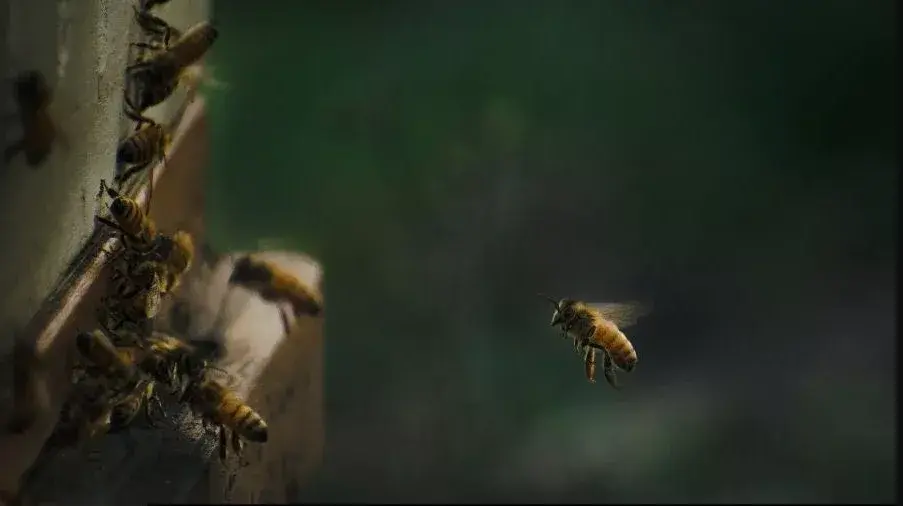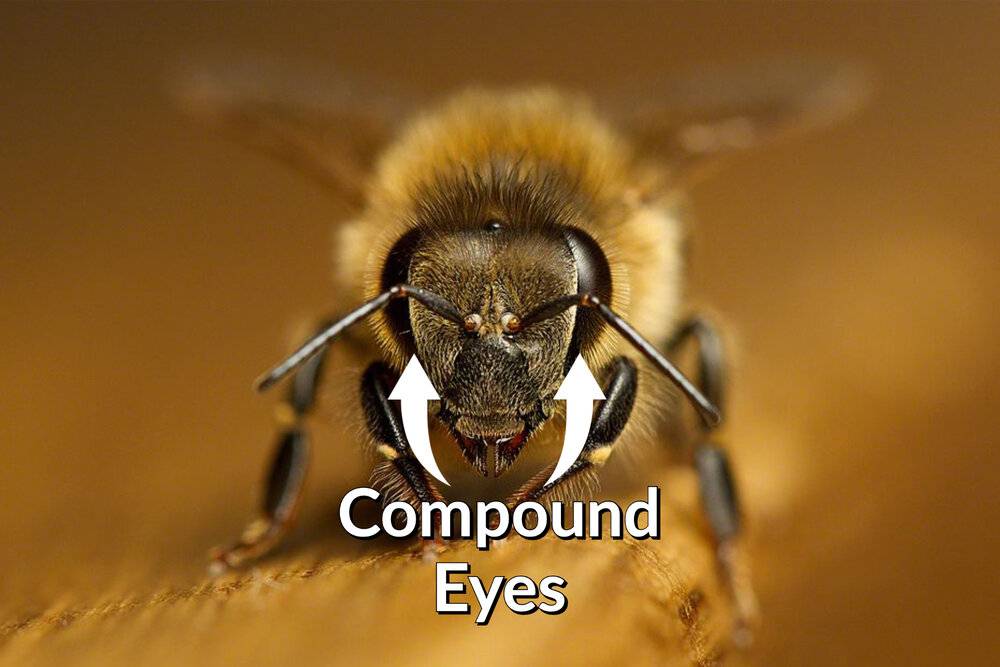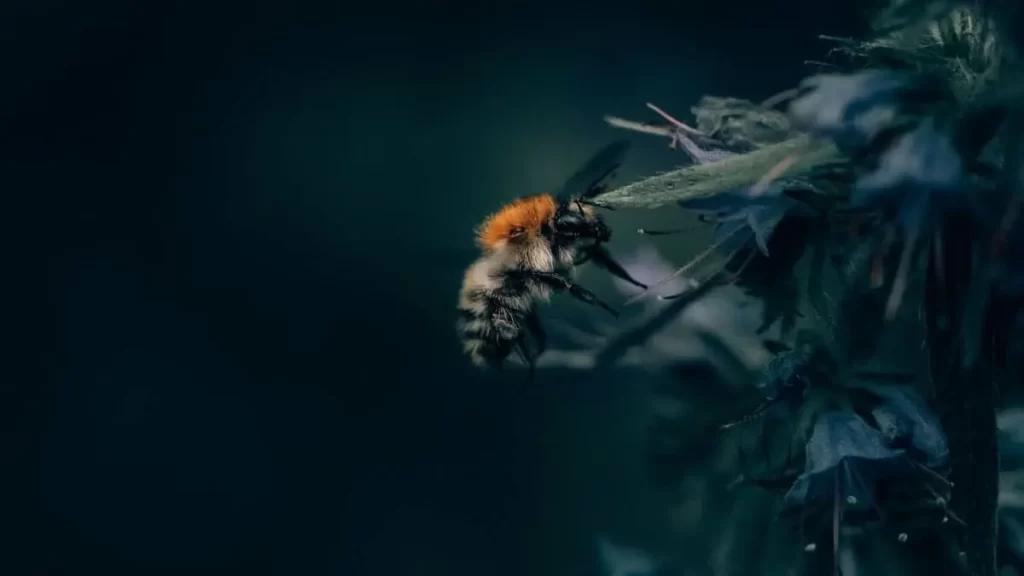Most bees are active only during the day, but did you know that there are species that are active during the night, as well. Some types of bees prefer to do their activities at night, such as collecting nectar, pollen, bringing water, and other jobs. However, there are several reasons why nocturnal bees differ from diurnal bees.
Do Night Bees Really Exist?
The answer is YES. However, if you were to ask someone do bees fly in the dark, mostly you would get the answer NO, because, most people think of hard-working diurnal species, such as the common bee, that gather pollen and nectar in sunny meadows. And such images aren’t misleading — most bees are actually diurnal.
By sunset, most bees are safely back to their nests, finishing their daily work. But for some bees, the setting sun marks the start of a night of work instead. For these night shift workers, collecting pollen and nectar can be done almost in the dark.

Some species forage throughout the night and therefore must be nocturnal. One is the giant Indian carpenter wasp of the genus Carpenter, which forages even on the darkest moonless nights. Others are twilight, meaning their activity is limited to the slightly brighter hours after sunset and/or before sunrise.
Some of these bees may even continue to forage all night by moonlight. The dark world experienced by all these nocturnal bees is actually quite a challenge—bees rely heavily on vision for food, and recent research shows that nocturnal bees are no exception.
Can Bees Fly At Night?
As I have already stated, most bees are daytime flyers and they limit their food search activity only during the day and when daylight begins to fall, they return to their hives because it is more difficult to see and avoid obstacles when it is dark.
But there are rare species of bees that can fly in low light or even complete darkness. There are mostly tropical species which have evolved to see and fly at night. However, in order for their nocturnal activity to be justified, there must be certain flowers that open at night and give nectar.
Of course, there are such flowers, e.g. moon flower and jasmine, both of which bloom at night. This is an advantage for nocturnal bees because they do not have to compete with insects that only collect pollen and nectar during the day.
What Species Of Bees Fly At Night?
It is known that there are 7 species of bees that can fly in the dark and in reduced visibility. They belong to the bee families: Apidae, Andrenidae, Colletidae and Halictidae.
From the Halictidae family they are:
- Megalopta atra,
- Megalopta centralis,
In addition, there are many more crepuscular species of bees that can fly in reduced visibility, namely:
- Caupolicana ocellata,
- Caupolicana yarrow,
- Lasioglossum (Sphecodogastra) galpinsiae,
- Martinapis luteicornis,
- Megalopta genalis,
- Peponapis genus,
- Ptiloglossa arizonensis,
- Ptiloglossa guinea,
- Ptiloglossa jonesi,
- Xenoglossa fulva,
- Xylocopa tabaniformis,
Species able to fly if there is adequate moonlight (at least a half-moon) are:
- Lasioglossum texana,
- Apis dorsata,
- Apis mellifera adansonii,
Why Did Some Bees Transform Into Night Planes?
Some bees have become nocturnal precisely because of the strong competition during the day, so that competition among pollinators is reduced during the darker hours. You will notice that where nocturnal bees are found, there are many plants that open only at night or produce nectar during both day and night. While diurnal bees have to compete with other diurnal pollinators to collect sufficient amount of nectar and pollen from flowers that open during the day.
However, nocturnal bees also have minor difficulties and obstacles during their nocturnal activities, namely moths and bats.
There is a probability that the flowers give nectar and pollen most abundantly in the morning hours and around dusk, which forced the bees to collect these resources even though the light was weak, so that these resources from flowers would not remain unused.
Another reason why some bees become nocturnal could be that it was the best time to avoid predators and parasites, both of which are major threats to bee population.
Read article: Do Bees Sleep? Do Bees Sleep In Flowers?
Do Bees Fly In The Dark?
You must have wondered do bees fly in the dark, and can bees fly at night. Yes, nocturnal bees are adapted to fly at night without problems thanks to their large eyes.
However, diurnal bees can also fly with reduces visibility for a certain period of time using some tricks. They fly at night by performing image processing to help them see better in very low light. They can use their brains to extend the time period during which their photoreceptors collect light before sending a signal, but this could make moving objects appear blurry.
Another method is to collect the signals from all their photoreceptors in an effort to create one complete mosaic image. But his could reduce the detail in the images that are produced. None of these techniques work very well. And because of that, nocturnal bees have a great advantage.
Are Some Bees Unable To Fly In The Dark?
Most bees fly during the day because that’s when they are most productive, and they use the night time to conserve energy for foraging for food the next day. Other than being less able to see at night, these daytime bees have no good reason to leave their nests at night unless absolutely necessary. They can fly in the dark, but they choose not to.
However, the bees’ ability to fly at night is impaired — even for nocturnal bees. The genus Megalopta is known as sweat bees and includes many nocturnal species.
The researchers measured the landing time after returning to the nest, and the slower landing time was not due to the bees’ slow flight, but rather to erratic flight and an error-prone, clumsy approach.
Even with larger eyes, nocturnal bees still can’t rely on vision alone to guide them back to their nests. As mentioned, they also need to use their brains. But despite using everything at their disposal, they were not well adapted to night flying.
Eyes Of Nocturnal Bees Vs. Eyes Of Diurnal Bees
Nocturnal bees have eyes that have evolved to see at night and in reduced visibility. In particular, their eyes adapted to lower light conditions so that their eyes became larger over time than other species.
For example, one study has shown that the Megalopta genalis sweat bee (a nocturnal type) has larger compound eyes, larger facets, and an optical sensor that is 27 times larger than Apis mellifera (the European honeybee).
An interesting comparison shows that the eyes of the diurnal carpenter bee (Xylocopa ruficornis) are half the size of the eyes of the nocturnal Indian carpenter bee (Xylocopa tranquebarica).
Not all night-flying bees can see in complete darkness. Some need low light levels, either twilight or moonlight. These are known as crepuscular bees. They are active both at dawn and dusk.
How Do Bee Eyes Work?
The bee has three small dot- and two large compound eyes. Dotted eyes are quite small and simple, and in their essence are built similar to the eyes of humans and higher animals, but they are not movable. They consist of a lens above a layer of very simple, elongated retinal cells connected by a nerve fiber. It is assumed that their role is to detect the intensity of light falling on the lens.

Compound eyes are significantly larger, oblong, fixed, and located on the sides of the head. Their structure and function are significantly different from human eyes. They are composed of several thousand small parts, each of which represents a separate eye. The cornea of a compound eye consists of regular hexagonal chitin plates (facets), so compound eyes are also called faceted eyes. there are small hairs on the edges of the facet.
The number of facets on a bee’s eye is very large, ranging from 4,000 to 5,000 for the worker, about 5,000 for the queen, and 8,000 to 10,000 for the drone.
Under each facet there is one eye unit (ommatidium), which has the shape of a narrow tube that gradually narrows towards the depth of the eye. The wall of those tubes is covered with a black pigment layer, so the light ray that enters the eye unit from the outside cannot pass to the neighboring one.
On the upper side of each eye unit there is a six-sided chitin lens and below it a crystal cone that turns into a visual rod (rhabdom), which reaches all the way to the eye tube and is connected to the optic nerve. The optic nerves of each individual tube pass into the basement membrane. It is assumed that the bees assemble the image like a mosaic. Without compound eyes bees behave as if they were blind, while without simple eyes they can see.
Bees see well the main colors of the spectrum: yellow, blue-green, blue, and ultraviolet. They do not see the color red, i.e. they see it as a dark grey to black.
So all of the above gives us an affirmative answer to the questions do bees fly in the dark and can bees fly at night.
Does Geographic Location Play A Role In Bee Night Flight?
After I have written about can bees fly at night and whether are bees nocturnal, I will mention the influence of geographical location on night flying of bees.
Certain species of night bees live in very dry regions or at high latitudes. They may have adapted to flying at night because they are better able to forage when the sun is less hot and water is less readily available.
However, most nocturnal and evening active species live in tropical or subtropical regions. Many plants in these areas are very fragrant at night and produce copious amounts of nectar. Night and evening bees may have adapted to flying at night as a way of avoiding competition with the much more diurnal bees and other pollinating insects.
Do Nocturnal Bees Collect Food In The Same Way As Diurnal Bees?
Examining nocturnal bees and observing their habits food collection is a bit difficult due to the lack of light,, but similar strategies appear to exist for both diurnal and nocturnal bees.
Both diurnal and nocturnal bees visit flowers far from their nests. This is of course easier for diurnal bees as they can see their way home better.
Diurnal bees rely on their vision to identify landmarks on their foraging paths so they can return to their nests and remember these locations for later. Bees pass this information on to other bees in the hive.
Nocturnal bees can also learn where their nests are relative to floral landmarks — using their polarized vision to do so. However, their flight patterns are different from those of sun bees.
As they fly away from the nest, they turn toward the nest in midair—perhaps to mentally photograph the landmark. They then fly in wide arcs to survey all possible landmarks. It’s unclear whether they knew where the landmarks were on their foraging paths while flying this way.
How Do Night Bees Find Flowers In The Dark?
Bees use visual and chemical cues about flowers to locate flowers and access food resources such as nectar and pollen. So they use the shape, brightness, color, and smell of flowers. Since bees have very limited activity at night to gather food resources, one might expect that these bees would have to be very efficient at finding flowers.
Night bees have several visual adaptations to cope with low light compared to daytime bees. They typically have larger juxtaposed compound and monocular eyes, optical mechanisms to improve light capture in dim light, and specialized neural mechanisms to improve visual performance by increasing retinal signal reliability and summing photons in space and time.

Light intensity threshold determines flower foraging behavior more than other abiotic environmental factors. In addition, nocturnal bees tend to visit flowers with broad-spectrum albedo, likely to form high-contrast white targets against the dark background of sky and vegetation.
In addition to visual adaptation to low light, nocturnal pollinators often rely heavily on floral scent to find host flowers. In fact, nocturnal bees tend to visit and be attracted to flowers that emit strong odors with volatiles at night from various biosynthetic pathways.
For example, nocturnal bees are attracted to the strong odor of Campomanesia phaea flowers, which are mainly composed of aromatic compounds (2-phenylethyl alcohol and benzyl alcohol) and aliphatic compounds (1-octanol and 1-hexanol )composition. Paullinia cupana (Sapinaceae) emits a floral fragrance attractive to nocturnal bee pollinators, including the terpenoids linalool and (E)-β-ocimene, and the nitrogenous compound phenylacetonitrile.
These available data suggest that strong floral scents, consisting of compounds widely distributed in floral scents, are important sensory cues used by nocturnal bees to find host flowers.
Conclusion
Not all bees are created equal. Bees cannot see like humans. In fact, technically, the bees can’t see it at all! Instead, bees use the sun’s polarized light to orient themselves. A bee’s eye has a compound shape of thousands of lenses. Above their compound eyes, they have three simple eyes that help detect light and movement.
However, certain species of bees can be seen at night. Some bees are evening. They usually travel at dusk, night and early morning. These special bees can fly at night in low light. Other bees are completely nocturnal, such as sweat bees.
The eyes of these rare bees are very different from those of day-flying bees. These bees do this to forage for nectar at night when there is less competition, and to collect pollen from nocturnal flowers. These different bees show what makes bees truly special.
